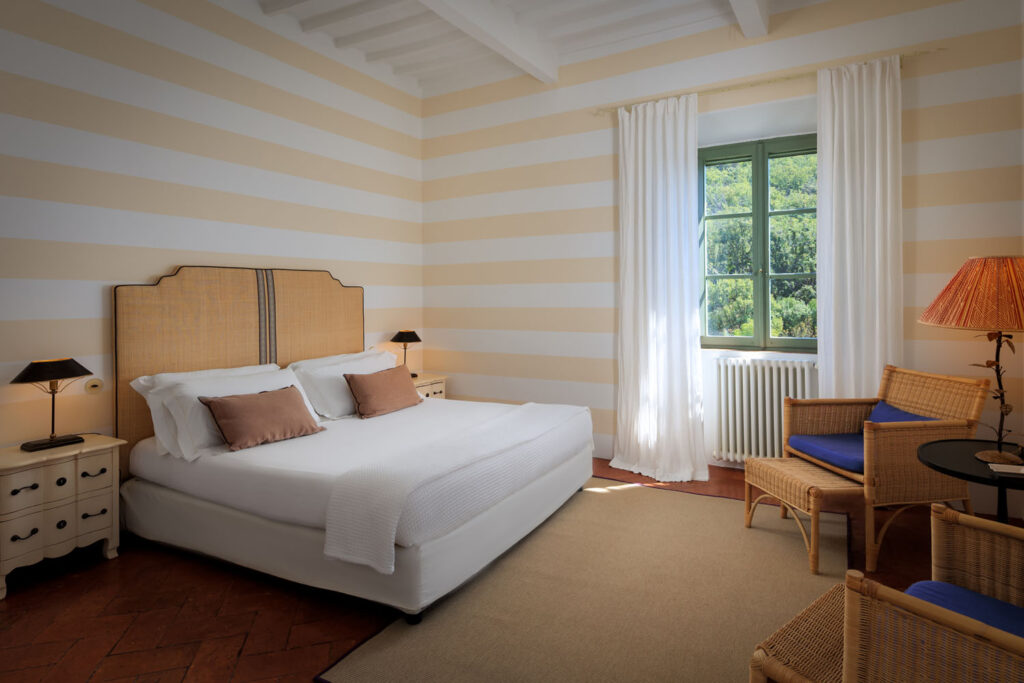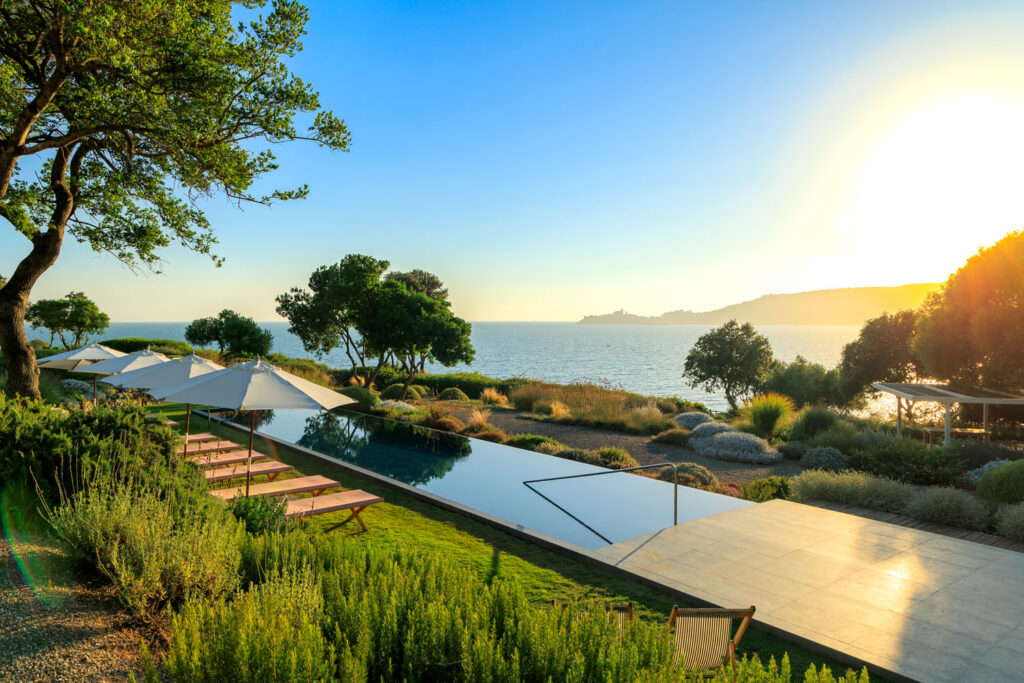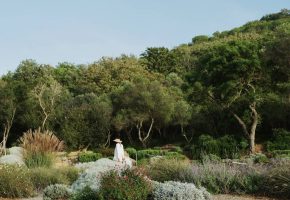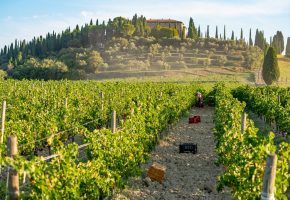Bolsena Lake
DON’T MISS
Bolsena. Monaldeschi Castle and the Territorial Museum of Bolsena Lake. Built in the 12th century to protect the Via Cassia, this castle was renovated and enlarged by the Monaldeschi della Cervara, who controlled Bolsena between the 14th and 15th centuries. Partially rebuilt in the 16th century, it was destroyed several times, the last time in 1815 by the inhabitants of the city to prevent it from being handed over to Luciano Bonaparte, Napoleon’s brother. Restored in the 1970s, it was transformed into the Territorial Museum of Bolsena Lake in 1991 and exhibits archaeological, naturalistic and anthropological models that illustrate the history and traditions of the area.
Basilica and Catacombs of Santa Cristina. The Basilica of Santa Cristina was built just outside the walls of ancient Volsini, above an ancient Paleo Christian cemetery where the remains of the saint were believed to have been buried. According to the legend, she was martyred in Bolsena at the time of the Emperor Diocletian. What remains is an extensive and branched catacomb complex, with some intact tombs, epigraphs and fragments of frescoes. The saint’s relics are inside an urn of the Roman imperial era enclosed in a peperino sarcophagus and were found in 1880. They date back to the 11th century BC, when, according to legend, the countess Matilde di Canossa founded the cathedral. The church has a Romanesque character. The capitals were unfortunately damaged in restoration works at the end of the 1700s. The 8th-9th century ciborium is placed on the so-called Altar of Four Columns. The elegant late 15th century facade was instead commissioned by Cardinal Giovanni de’Medici. It was inside this church that locals believe the so-called “Miracle of Bolsena” took place in 1263. The event is celebrated each year with the Feast of Corpus Domini and the stones that were said to have been stained by the blood that flowed from the host at consecration have been preserved.
Archeological area. Several monumental remains from the ancient Roman city of Volsini can still be seen today. In Poggio Moscini, where the ancient forum was located, you can see the remains of different public buildings, paved streets and houses with frescoed rooms.
Caves of Castro and Necropolis. Located about three kilometres from Grotte di Castro, between the town and the lake of Bolsena, the necropolis of Pianezze is home to the area’s most important Etruscan necropolis built on the plateau called La Civita. The sepulchral group consists of 24 chamber tombs with several rooms. Of particular interest is one shaped like a house with the details of the roof beams in red.
Valentano. The Tuscia Museum of Prehistory and the Rocca Farnese. The first nucleus of the fortress of Valentano dates back to the 11th century. Widened and renovated several times over the centuries, it was transformed into a residential building by the Farnese family in the 15th century with the creation of the so-called “lovers’ courtyard”, in honour of the marriage between Angelo di Pier Luigi Farnese and Lella Orsini, celebrated in 1488. At beginning of the 16th century, further renovations were undertaken by Antonio da Sangallo, who designed the central well. Pope Paul III Farnese (1534) build the external loggia that still characterizes the panorama of Valentano today. Abandoned by the Farnese family after the fall of the Duchy of Castro (1649), it became a monastery for Dominican nuns in 1731 and was adapted it to their needs. After the nuns moved to Gubbio, the fortress was destined for civil use (schools, homes) and was abandoned in 1957. Restored in 1979, it has hosted the Tuscia Museum of Prehistory since 1996, displaying important artefacts from the Palaeolithic to the Iron Age sourced throughout the province of Viterbo.
Montefiascone. Church of San Flaviano. A Romanesque-Gothic church rebuilt several times starting from the 11th century. It consists of two superimposed buildings. The lower part, dating to shortly after 1000, and the columns and pillars with variously decorated capitals and numerous frescoes dating from the 14th and 15th centuries. The upper church, with its facade enlivened by three Gothic arches surmounted by a 16th-century loggia, has an elegant interior with three naves and a large central opening on the floor, sealed by an 18th-century gate that allows you look into the environment below. The papal seat was made out of travertine, surmounted by a canopy, in 1262 when Pope Urban IV went to the basilica to consecrate the altar.
Church of Santa Maria di Montedoro. Located a few kilometres from the town of Montefiascone, the church, once known as Santa Maria di Monte Moro, has an octagonal plan and was designed by Antonio da Sangallo in 1523 on the site of an earlier chapel. A supposedly miraculous image of the Madonna with the Child is still visible on the main altar and attributed to Antonio del Massaro, called the ‘Pastura’ (second half of the 15th century). The five chapels in the interior also bear frescoes from the second half of the 16th century.
HISTORY
Bolsena is the largest lake of volcanic origin in Europe and the second largest lake basin on the Italian peninsular, by extension, after the Trasimeno. It fills a depression created about 320,000 years ago by the collapse of magma pockets due to eruptions from the volcanoes in this area, including those on which the towns of Valentano and Montefiascone would rise. It is essentially filled by rainwater, as well as by some very short watercourses and springs located in its basin. It has a single emissary, the Marta River, which flows into the Tyrrhenian Sea after lapping the city of Tarquinia.
The last volcanic eruptions date back to around 120,000 years ago. The first traces of inhabitation date back to the Middle and Upper Paleolithic (100,000-35,000 and 35,000-10,000 years ago, respectively) and have been identified above all in the southern part of the basin. Traces of the other periods of prehistory, from the Neolithic period to the Bronze Age, are not abundant. On the other hand, finds from the early Iron Age (9th-8th century BC) are more common as we know the lake’s water level was about 7m lower than the current one. The settlement at Gran Carro dates back to this period and is on the eastern shore of the lake, now submerged. The origins of the important centre of Bisenzio on the southern shore are also from this period.
In Etruscan times, the lake was controlled by the important Etruscan cities of Volsini (Orvieto) and Vulci, which probably also ruled the centre of Bisenzio, and, at a later date in Etruscan history, also Tarquinia. The settlements that occupied the elevated crown of the lake were numerous. The most important included La Civita di Grotte di Castro on the ridges to the northwest of the basin.
In 264 BC, the legions of Rome conquered the last independent Etruscan city Volsini, located on the cliff of Orvieto. Contrary to the conquest of the neighboring cities of Tarquinia (281 BC) and Vulci (280 BC), the Romans did not confine themselves to confiscating part of Volsini’s territory, but razed the city and forced its inhabitants to move to a new settlement especially built near the shores of the lake, the current Bolsena. The city maintained the same name: in Etruscan, Velzna or Velsena, in Latin, Volsini. According to some sources, the Roman intervention was encouraged by the local aristocracy after riots by the servile classes seeking to seize power. The sacking of the city would have yielded as many as 2,000 bronze statues. Volsini grew in importance over time, especially after the construction of the Via Cassia in the second century BC. In the early Imperial age, it was already a famous holiday resort, mentioned by the Latin poet Juvenal.
At the beginning of the IV century BC, there was the earliest evidence of a Christian communities, testified by the catacombs of Santa Cristina in Bolsena. Between the end of the fifth and the beginning of the sixth century AD on the other hand, we find the earliest evidence of the existence of a diocese of Volsino. There was another in the city of Bisenzio on the opposite bank of the basin. On an island in the lake (Bisentina or Martana), Queen Amalasunta, daughter of Teodorico, king of the Ostrogoths, was exiled and then murdered in 535 by her husband and cousin Teodato.
In the 11th century, San Lorenzo, Grotte di Castro, Gradoli, Latera and Bisentina island were ceded by the Countess Matilde di Canossa to the Church, which thus added them to the Val di Lago. The powerful Municipality of Orvieto, however, excised its influence over this entire territory, sometimes in contrast with that of the Church. In 1281, Pope Martin IV visited Bolsena. It seems that during his stay, he tasted the lake’s eels. He enjoyed them so much that Dante awarded him a place in the sixth ring of Purgatory, among the gluttons.
Located on one of the main routes of communication between Rome and the north, the whole Val di Lago was repeatedly crossed and sacked by foreign troops heading towards the capital of Christendom or the south of Italy. Among them were those of the emperor Louis IV, called the Bavarian, in 1328 who, after his coronation in Rome, intended to obtain supplies to wage war against the kingdom of Naples. The emperor also besieged the city of Bolsena, without succeeding in conquering it.
In 1369, Pope Urban V moved the papal seat to Rome after the capture of Avignon, but was forced by a series of riots to leave the city, finding refuge in Montefiascone. In gratitude for its loyalty to the papal throne, he granted it the status of city and elevated it to the seat of the diocese, detaching it from that of Bagnoregio and shaping its territory from that of the surrounding dioceses (Viterbo, Tuscania, Orvieto and Castro).
An interesting picture of the Val di Lago in the 15th century is offered by the Commentaries of Pope Pius II Piccolomini, a relation of the Monaldeschi, lords of Orvieto and Bolsena, who visited these areas between 1460 and 1462. He describes Bolsena as devastated by numerous internal wars and remembers how Martana Island, after a long period of abandonment, was inhabited by Augustinian friars, while Bisentina Island was home to the minor friars of San Francesco.
In 1537, Pope Paul III established the Duchy of Castro, which included the southern and western shores of the lake, with the settlements of Marta, Capodimonte, Bisenzio, Valentano and Grotte di Castro, entrusting it to his son Pier Luigi Farnese. Subsequently, a tense and dangerous situation arose between the family and the papacy due both to the numerous debts accumulated with the Church, and the Pope’s ill-advised decision to make Castro the capital of the duchy. This crisis reached its peak in the 1600s and culminated in 1649 when Castro was conquered by the papal troops. It was completely destroyed and the entire duchy returned to the direct control of the Church.
In the 18th century, the level of the lake rose and numerous marshlands formed along its banks. These quickly turned putrid, forcing Pope Clement XIV to order the evacuation of the small town of San Lorenzo alle Grotte, in the immediate vicinity of the coast, moving its inhabitants to a new town, about 2 km from the abandoned one, called San Lorenzo Nuovo in 1779.
The Val di Lago area was repeatedly affected by the Risorgimento. In 1860, a group of Garibaldini led by Colonel Zambianchi left the 1,000 at Talamone and, after meeting in Pitigliano, crossed the border, occupying Latera and Grotte di Castro. However, a French detachment headquartered in Montefiascone with the support of the Papal troops stationed in Valentano, managed to drive out the patriots, regaining control of the territory. A similar event was repeated in 1867, when Garibaldi tried to organize an expedition to occupy the Papal State and conquer Rome. The general was stopped by the Italian authorities, who arrested him and transferred him to Caprera. From here, however, the general managed to escape. In the meantime, groups of volunteers merged on the Viterbo area, undertaking numerous attacks. They occupied Ischia di Castro, Farnese, Acquapendente and Valentano, but, when attacked, took refuge in the convent of S. Francesco in Bagnoregio. The papal troops, however, organized themselves quickly and, after meeting in Montefiascone, drove the “brigands” or “bandits” across the border, regaining control of the entire area. However, after Garibaldi’s victory at Monterotondo, papal troops abandoned all their garrisons, afraid of an invasion from the regular troops of the Savoy and concentrated their efforts on Rome and Civitavecchia, where they expected the French reinforcements to land. The Garibaldini decided to take advantage of the situation, leaving their base in Torre Alfina to occupy Viterbo, taking control of the strategic strongholds of Bagnoregio, Valentano and Montefiascone, placing the latter under their military command. But just when the plebiscite had begun to welcome annexation to the Kingdom of Italy, news of Garibaldi’s defeat at the Battle of Mentana arrived. The Garibaldini therefore abandoned all their positions and left the Papal States. Only in 1871, with the fall of Rome, did the territory of Bolsena Lake finally became part of the Kingdom of Italy.





